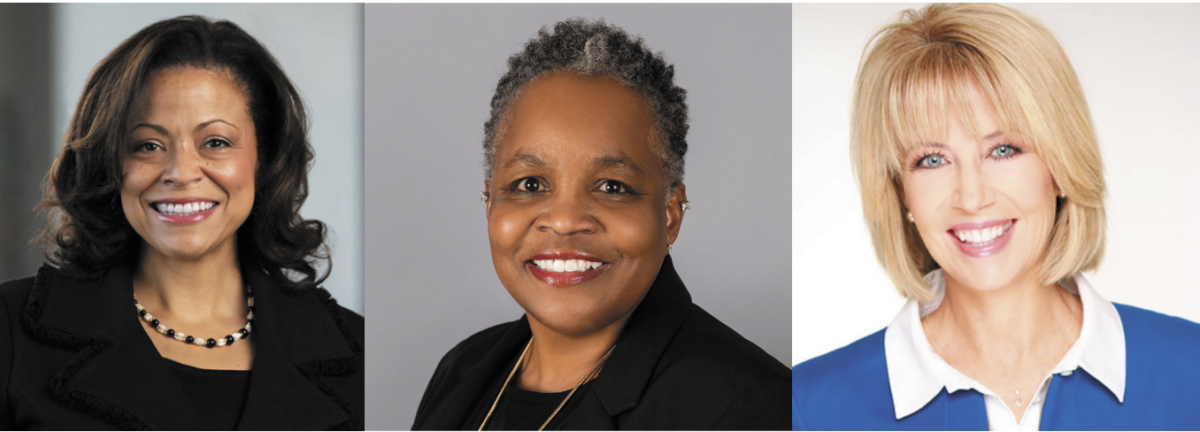
From left: Nicole Taylor, Cassandra Little, Ashley Swearengin. Photos contributed.
Written by Ben Hensley
Nonprofit organizations are a driving force keeping communities together both in times of need and prosperity; whether it’s providing food for people suffering from homelessness, mental health centers for those in times of crisis, or empowering those in need of emotional, monetary, or spiritual support, nonprofits help communities not only stay together, but thrive together.
Compared to the rest of the country, California nonprofits employ a significantly higher percentage of women on their staff and board leadership, in addition to women making up 63% of the nonprofit workforce, according to a report from CalNonprofits.
Despite all of this, and California leading the way in many nonprofit employment categories, various online blogs and research sites claim that nationwide, while around 65% of people working at nonprofits are women, only around 20% of these are in CEO or C-Suite positions.
“If you’ve not seen a lot of female leadership in the C-suite, it’s really easy as a woman to just eliminate yourself from consideration,” said Ashley Swearengin, former Fresno Mayor and CEO of the Central Valley Community Foundation.
Swearengin, who served as Fresno’s mayor from 2009 until 2016, now serves as CEO of the CVCF. Her experience was not an easy one, but drew from her own personal confidence and support from others.
“A lot of times, people sit it out and assume that they’re not qualified or capable,” she added.
Swearengin added that during her mayoral run, she also encountered situations where she felt as though she was stigmatized, due to her level of experience and gender.
“I was hearing a lot of people say, ‘you’re never going to get elected,’” Swearengin said, adding that the naysayers would focus on her lack of experience in running a business. “It was a conventional viewpoint and I do understand it, but it turns out they were wrong.”
The inequities don’t stop at gender though; race also plays a large role in disparities among women in C-suite roles.
Nicole Taylor, CEO of the Silicon Valley Community Foundation, explained the deep-seeded inequities she witnessed firsthand.
“After graduating from Stanford University, I began my teaching career as a student teacher in Palo Alto, and then went on to teach middle school science in the Oakland Unified School District,” Taylor said.
“The social and economic disparities between the two school districts were shocking,” she said, explaining that witnessing these disparities quickly motivated her to change career paths from teaching to nonprofit and philanthropic industries, hoping to pursue work enabling her to help drive change for equity.
For Taylor and many like her, race also plays an impact in representation in the C-Suites.
“When I first took on the role at SVCF, I struggled with the notion that wearing my hair in its natural, curly state might not be considered professional enough for the CEO of the largest community foundation in the country, and that I would be judged for my appearance,” Taylor explained.
She has since broken away from that line of concern, choosing to represent herself as she sees fit.
Taylor believes that achieving more DEI (diversity, equity and inclusion) makes business sense.
“If you have the same type of people, from the same backgrounds, making decisions for a company or organization, you will not arrive at all of the best possible solutions,” she explains. “If a team does not reflect the community or client base it wishes to serve, how can it hope to have the best possible impact?”
Dr. Cassandra Little, CEO of the Fresno Metro Black Chamber of Commerce, believes that while women in C-Suites are trending in the right direction, there is still work to be done in the interest of DEI.
“We do see some elements of change, but we also see a lot of regression too,” she said, explaining that at times it feels as though progress moves “two steps forward, one step back.”
Like Taylor, Little believes that it is extremely important to be confident in representing yourself.
“The intersectionality of being a female and being a black female, and then I’ll put on top — being a gay, black female; I always tell people that when I walk through the door that it’s important for me to walk with all of who I am,” Little said, adding that it all comes down to representation.
“A lot of times people don’t feel that you’re capable, or people are quick to judge before they even know your skill level,” she added.
While she takes pride in her personal accomplishments, Little attributes a lot of credit to her success to her predecessor, Tara Lynn Gray.
“She brought in a real good team of young people, which is important, and that makes my job 80% easier,” Little said. “The other 20% is keeping it going.”
Swearengin added that despite facing challenges in her own personal journey toward the C-Suite, executives and future executives have a smoother road now because of the former generations.
“I see a generational shift from hearing stories from my mom and my grandmother, my own experience, and then looking at my daughter’s new experience,” Swearengin said.
“Things are going in the right direction,” she said.
With California trending in a positive direction with regard to women in executive positions, all three women see positive trends for the future.
“We’ve seen a lot of progression, but we’ve seen so much backlash and regression socially,” Little said, adding that when that happens, she follows John Lewis’ quote: “It’s ok to fight the good fight.”
“We just have to keep fighting the good fight for change.”








